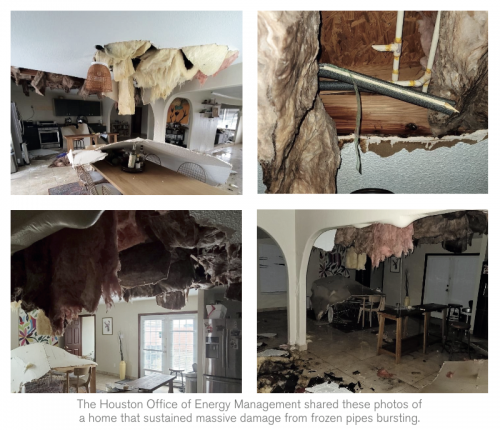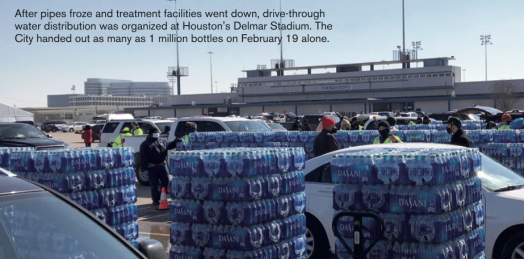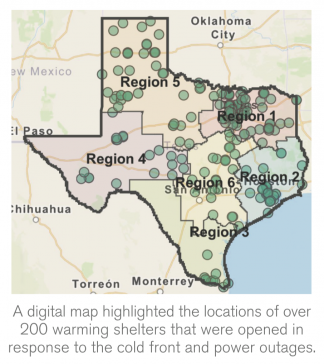All
The Cold, Dark Future of Electrification
by Samuel Diamond

Widespread blackouts, high energy costs portend crisis for “electrify everything” movement
Power outages plunged more than 4 million Texas homes and businesses into
darkness last month as a crippling cold front overwhelmed the state’s electric grid. But lacking lighting was the least of many residents’ concerns.
The blackouts cut off Texans’ access to home heating while temperatures plummeted. All three of the state’s biggest cities — Houston, San Antonio and Dallas — had over 150 more heating degree days than normal for the week of February 14-20. Wichita Falls, which normally has all of 134 degree days for this period, had 356.
More than 30 people in the state died as a result of the winter weather.
Additionally, heat and light weren’t the only basic services in short supply. Many people lost access to running water as their pipes froze. Equally disturbing, millions of Texans who did have running water were advised to boil it before drinking it, as hundreds of treatment plants experienced outages and other issues.
Without exaggeration, the power grid failure in Texas rendered much of the state a devastated and dangerous living environment lacking even basic human necessities like clean drinking water, not to mention relative luxuries like lights, refrigerators, heat, and hot water for bathing.
Worse still, all of this unfolded during a pandemic, with Texas reporting 202 COVID-19 deaths and 5,532 new cases during the week of February 14-20.
![]()
As for the cause of the grid failure, fingers have been pointed in many directions. A deregulated electricity market, overextended natural gas supplies, climate change, extreme winter weather, and even frozen wind turbines have caught some of the blame.
Investigations are ongoing; more on that later. For now, what’s clear is that Texas’s grid was not able to withstand the spike in electricity demand that resulted from last month’s polar vortex conditions.

The grid’s operator, the Electric Reliability Council of Texas (ERCOT), is not connected to neighboring states’ grids and does not have a forward capacity market, which would incentivize power generators to prepare for peak demand periods by investing in dual fuel systems and stocking up on liquid fuels for when other resources are overstretched. In New England, for example, power generators typically keep about 1 million barrels of distillate fuel and over 2 million barrels of residual fuel onsite in February, especially for use during peak demand.
ERCOT CEO and President Bill Magness said Texas’s grid lost 52.3 gigawatts — almost half of its entire generation capacity — at one point on February 14. Early the next morning, the grid was mere minutes from a complete system-wide failure that would have knocked out power for the entire state, possibly for months.
If concepts like generation capacity, forward markets and peak demand inventory don’t quite resonate, consider this: on February 15, Texas’s wholesale electricity prices spiked by more than 10,000 percent to over $9,000 per megawatt hour. For some residents who didn’t lose power, or who had it restored, the price spike proved far more devastating than the polar vortex.
Army veteran Scott Willoughby, of Royse City, Texas, owed his electricity provider $16,752 and said his brother owed more than $9,000. “We are both retired veterans on fixed incomes and this has wiped us out,” Willoughby wrote on a GoFundMe page started to help cover the costs. “Mine went on my credit card and once paid, will almost wipe out my savings and my brothers [sic] came straight out of his bank account causing an overdraft.”

![]()
The Federal Energy Regulatory Commission (FERC) announced two investigations in response to the crisis: one aimed at possible market manipulation by natural gas and electricity wholesalers (see “FERC to Examine Potential Wrongdoing During Cold Snap” on page 40) and another on the issue of electricity reliability.
On February 22, FERC said it would open a proceeding to examine the threat that climate change and extreme weather events pose to electric reliability. The proceeding would examine how grid operators prepare for and respond to weather events like droughts, extreme cold, wildfires, hurricanes and prolonged heat waves.
“The effects of climate change are already apparent, and we must do everything we can within our statutory authority to ensure that the electric grid is capable of keeping the lights on in the face of extreme weather,” said FERC Chairman Richard Glick.
On the West Coast, where wildfires have been linked to grid issues, and in the Northeast, which is no stranger to extreme cold, climate change activists have proposed banning liquid fuel and natural gas hookups in new buildings and complete electrification of the transportation and heating sectors.
However, energy analysts’ studies have shown that this “electrify everything” movement would push even the relatively energy-diverse New England grid into uncharted territory. Data presented by ISO New England Planning Advisory Committee participant Ray Albrecht indicated that replacing 89 percent of heating oil systems and 63 percent of natural gas heating systems with electric heat pumps would add approximately 25,000 megawatts of electricity demand and could double wholesale power supply costs (see “Loose Screw Economics” from page 30 of our November/December 2019 issue).
![]()
In response to the crisis, NEFI’s Net-Zero Task Force produced and distributed communications highlighting renewable liquid heating fuels’ benefits for both emergency response and year-round use. A press release issued Friday, February 19 furthered the industry’s case that renewable liquid heating fuels provide the most immediate and cost-effective solution for decarbonization and energy security. By Sunday, February 21, the story had been picked up by more than 100 media outlets, including local newspapers from Vermont to Texas.
“As an industry, we’ve been working on transitioning to low carbon fuels and advocating for their use for years,” said Cubby Oil & Energy President Charlie Uglietto, who leads the Net-Zero Task Force. “The situation in Texas, while devastating, further underscores our need for reliable, renewable, and diversified fuel sources like the biofuels we offer. We have a product that can meet the expanding needs of our country, while also drastically reducing GHG emissions. We have been advocating for many years to be included in the national discussion on energy mix; our hope is that now someone will finally listen. We are part of the solution to climate change.”
“Here in Vermont, many homeowners that have an electric air source heat pump received an email warning on February 12 that that their utility will ‘manage’ the device remotely to lower energy consumption during peak demand,” said Matt Cota, executive director of the Vermont Fuel Dealers Association. “This is not surprising and is understood as necessary by those in the energy policy arena because we are a winter peaking state. We have witnessed tremendous growth in wind/solar/hydroelectricity, biomass, renewable liquid and gaseous fuels over the past decade. Each fuel source has advantages and disadvantages and should be allowed to compete in the marketplace.”
The press release was developed in coordination with the Connecticut Energy Marketers Association, Delaware Valley Energy Marketers Association, Energy Marketers Association of Rhode Island, Fuel Merchants Association of New Jersey, Maine Energy Marketers Association, Massachusetts Energy Marketers Association, Northeast Pennsylvania Energy Marketers Association, South Central Pennsylvania Energy Association and the Vermont Fuel Dealers Association.
The Massachusetts Energy Marketers Association (MEMA) also issued a press release, including the following statement from MEMA President Michael Ferrante: “As Massachusetts and other states move towards decarbonization, more and more demand will be put on the electric grid. It is imperative that a mix of clean energy sources be used to meet the energy needs of Massachusetts residents moving forward. By providing a clean and more affordable alternative to electric heating, BioheatÆ fuel ensures that the electric grid can handle winter loads.”
![]()
Supporting the notion that liquid fuels remain a crucial part of the national energy mix, the Federal Emergency Management Agency (FEMA) had distributed 60 generators, 10,000 gallons of winterized diesel, and 10,000 gallons of gasoline to Texas as of February 21 to help support the state’s critical infrastructure.

“During these unprecedented extreme weather conditions, we see again the importance of diesel technology – proven, available and reliable – to key sectors of Texas’s economy and particularly the government’s ability to respond to crisis situations and protect and ensure public health and safety,” said Allan Schaeffer, executive director of the Diesel Technology Forum, in a statement released February 18.
Shaeffer noted that “all or nearly all” of the Texas Department of Transportation’s 700 snowplows and 200 motor graders run on diesel fuel.
A sobering indicator of just how bad the situation in Texas had become, FEMA also provided Texas with over 4 million
liters of water, 126,900 blankets and 1 million meals. As many as 1 million bottles of water were distributed in the City of Houston on February 19 alone.
Of the state’s 9,985,126 occupied housing units, 6,101,773 (61.1 percent) are heated by electricity, 3,499,082 (35.0 percent) by natural gas, 285,573 (2.8 percent) by propane, 28,184 by wood, 11,312 by solar energy, and just 6,632 by heating oil.
With 4,464,209 power outages reported on February 16, as many as 44 percent of Texas homes had no heat at all. Over 200 warming shelters were opened across the state.
Related Posts
 U.S. Competing to Secure Critical Minerals
U.S. Competing to Secure Critical Minerals
Posted on June 16, 2025
 The Clean Air Act, the EPA, and State Regulations
The Clean Air Act, the EPA, and State Regulations
Posted on May 14, 2025
 Day Tanks Support Back-up Generators in Extreme Conditions
Day Tanks Support Back-up Generators in Extreme Conditions
Posted on March 10, 2025
 Major Breakthrough in Lithium-Ion Batteries
Major Breakthrough in Lithium-Ion Batteries
Posted on February 12, 2025
Enter your email to receive important news and article updates.

